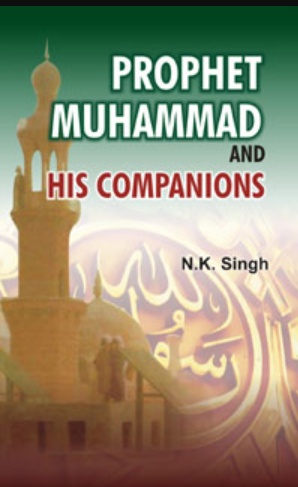– Dr Syed Wahajuddin Hashmi
Hyderabad
Book: Prophet Muhammad and His Companions
Author: N.K. Singh
Global Vision Publishing House, New Delhi, second edition 2016
Dr. N.K. Singh – a veteran researcher, known for his work on comparative religion and Oriental philosophy, serves as Director of the International Centre for Religious Studies in Delhi, and edits the quarterly journal Global Religious Vision. He has authored and edited several significant reference works, including:
- Islam in Western Perspective
- Islamic Mysticism in India
- God in Indian Islamic Theology
- Unseen God
- Encyclopaedia of the Holy Quran (5 volumes)
- Encyclopaedia of World Muslims (4 volumes)
- Encyclopaedia of Muslim Biography (5 volumes)
In his book Prophet Muhammad and His Companions, Dr Singh offers a compelling portrayal of Prophet Muhammad ﷺ and his early followers. Spanning over 390 pages, the book is a dual work of biography and historical reflection. The first section – just 21 pages – presents a focused narrative of the Prophet’s life and mission, while the remaining 365 pages are devoted to concise yet insightful profiles of 59 of his most devoted Companions. Through this structure, Singh sheds light on the ethical foundations of Prophetic leadership and the values of the earliest Muslim community – highlighting their roles in shaping a morally committed, socially just, and spiritually enriched society.
The book, as Dr Singh states, aims “to present the life and mission of Prophet Muhammad and his companions in an accessible and thoughtful manner.” (p. 3) It succeeds in doing so with academic diligence and interfaith respect rarely seen in Indian Seerah literature.
The book explores key episodes of the Prophet’s life. Beginning with the socio-religious milieu of pre-Islamic Arabia, the author outlines the Prophet’s early life, first revelations, momentous migration, (Hijrah) to Madinah, Prophet’s role in establishing an ethical-political order through the Constitution of Madinah – a foundational document for communal coexistence. The Prophet’s spiritual experience of the Mi’raj, the Treaty of Hudaybiyyah, his Farewell Pilgrimage, and passing are all addressed with clarity and balance.
Singh opens with a powerful observation that frames the whole book:
“Though it is doubtless true that great movements in history are not created by individuals alone, still the name of Muhammad… must be thought of as opening a new age.” (p. 3)
This framing situates the Prophet ﷺ not just as a religious figure, but as a civilizational architect who altered the trajectory of history. Singh argues that the emergence of Muhammad ﷺ as both spiritual and secular leader led to the Arabs’ transformation from historical obscurity to global prominence. This transformation, Singh contends, was directly tied to the Prophet’s teachings and leadership. (p. 3)
To understand the scale of this transformation, Singh devotes considerable space to the religio-social backdrop of 6th-century Arabia. He notes that while Makkans acknowledged the One God, they simultaneously believed in the intercessory power of idols. The pilgrimage to the Ka’bah, originally instituted by Prophet Abraham, had become a “spectacle of a commercial fair and an occasion of senseless idolatry.” (p. 3)
Born into this milieu, Muhammad ﷺ was orphaned at an early age, he was raised in modest circumstances and exposed to the hardship and social injustices of his time. Singh notes the Prophet’s integrity and leadership potential from a young age, citing his participation in Hilf al-Fudul, an alliance for protecting the oppressed. The Prophet ﷺ later said:
“If somebody should appeal to me even today, by virtue of that pledge, I shall hurry to his help” (p. 6) – an enduring testimony to his lifelong commitment to social justice.
Singh notes that the Prophet’s mission began with spiritual revelation but quickly assumed a socio-political dimension. At the age of 40, he received the first divine message, marking the start of a 23-year mission. His calls for monotheism, moral accountability, and justice were met with hostility by Makkan elites. The social boycott, economic sanctions, and personal abuse he and his followers endured are described by Singh as moments of “ethical trial” rather than merely political conflict.
The Prophet’s Ascension (Mi’raj), as Singh notes, symbolised divine affirmation of his mission and strengthened his resolve. Migration to Madinah followed, where he established the first Islamic state based on principles of mutual cooperation, interfaith tolerance, and social equity. As Singh notes, the Prophet ﷺ invited the region’s diverse communities – including “Muslims as well as the non-Muslim inhabitants of the region: Arabs, Jews, Christians and others” – to enter into a formal political arrangement. (p. 13) His capacity to bring together diverse religious communities under a common civic agreement – with justice, welfare, and liberty of conscience as guiding principles. Singh considers the Constitution of Madinah a landmark not only in Islamic history but in global constitutional governance.
Singh provides a detailed account of how Muhammad ﷺ reorganised the scattered Arabian tribes into a cohesive, moral polity. The Prophet’s leadership in Madinah is portrayed as both visionary and pragmatic:
“He created a well-disciplined state out of the existing chaos and placed peace in place of the war of everybody against everybody else.” (p. 21)
Dr. Singh presents the Prophet Muhammad ﷺ as a balanced figure – someone who brought forth generosity, established monotheism, created order out of disorder, turned enmities into alliances, and harmonised worldly governance with spiritual purpose. Singh expresses particular admiration for the Prophet’s commitment to justice and pluralism, especially under the Madinah Charter, which were central to this new order. As he puts it:
“He left behind a new system of law that ensured impartial justice, where even the head of state was subject to it like any ordinary citizen. Religious tolerance was so deep-rooted that non-Muslim subjects of Muslim states enjoyed juridical, judicial, and cultural autonomy. Above all, the Prophet Muhammad ﷺ set a noble example and fully practised all that he taught others.” (p. 21)
One of the most moving portions of the book deals with the bloodless Conquest of Makkah. Singh is struck by the Prophet’s mercy:
“The Islamization of Mecca which was accomplished in a few hours was complete.” (p. 16)
Instead of vengeance, the Prophet ﷺ granted general amnesty – an act Singh sees as a moral climax. Though the Prophet led numerous battles, Singh points out the low casualty count as proof of the movement’s moral rather than military nature:
“Only 250 non-Muslims were killed… Despite these few casualties, the entire Arabian Peninsula… was purged of anarchy and moral corruption. As a result of these monumental efforts, the entire Arabian Peninsula and parts of Iraq and southern Palestine willingly accepted Islam”. (p. 17)
A major strength of the book is Singh’s focus on the twin sources of Islamic ethics – the Qur’an and Sunnah. Citing the Prophet’s Farewell Sermon:
“I leave behind me two things: the Qur’an and my Sunnah. If you hold fast to them, you will never go astray.” (p. 19)
Singh writes:
“The Qur’an and the conduct of the prophet were to serve as the bases of law and a healthy criterion in every aspect of human life.” (p. 19) He further asserts, “By the perfection of this religion, it means that there’s no need for humanity, and for Muslims in particular, to look for another alternative way of life. As long as one holds fast to the two things left behind by the Prophet… one will never go astray.” (p. 19)
In a section titled A Guidance to Follow, Singh observes:
“Islam as brought by the Prophet Muhammad (PBUH) is very much understood, as a religion perceived to contain soul and ritual… thanks to the new development in the world, Islam is now looked in a wider perceptive than the narrow-minded view in the past.” (p. 19)
This statement reflects Singh’s belief that the modern world is finally beginning to recognise the depth and balance of Islam as a complete way of life.
The book concludes with a strong affirmation of the Prophet’s legacy as a guide for humanity. He acknowledges that the Prophet ﷺ exemplified every value he preached, making his life a living embodiment of the Qur’an – as famously stated by Aisha (RA). He writes: “That is why his conduct was exemplary of human conduct.” (p. 21)
A Model for the Present
In Singh’s interpretation, Prophet Muhammad ﷺ emerges as a figure of extraordinary moral clarity and pragmatic vision.
“He set a noble example and fully practised all that he taught to others.” (Preface)
Singh portrays the Prophet ﷺ as leaving behind a just legal system, an ethical state, and a tolerant society, unparalleled in his time:
“The teachings [of the Prophet] left for us, if put into practice in their true spirit and proper way, will bring a happy life in this world – and rewards in the next.” (Preface)
While certain interpretations in the book may prompt scholarly disagreement, Prophet Muhammad and His Companions remains a rare and commendable contribution.
In an age when Islam is often misrepresented, Singh’s work is both corrective and constructive. It invites readers – Muslim and non-Muslim alike – to re-examine the Prophet’s legacy – not as distant history, but as a relevant moral framework for addressing the crises of modern life.




